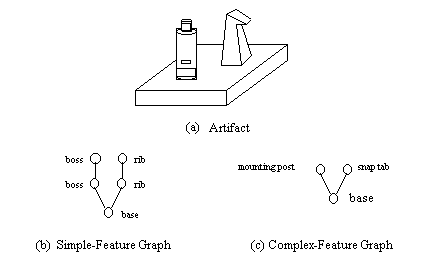6.2 FEATURE SPECIFICATION
6.2.2 COMPLEX-FEATURE GRAPHS
A complex-feature is defined to be a unique form and its attributes that is decomposable into one or more simpler features. Specialized evaluation occurs that is pertinent to that type of feature and no other. For example, a boss is a simple feature, an all boss draft angles can be evaluated for correctness. Although an ejector pin is made up of a boss, it may incur additional evaluations that simple bosses do not. Complex features are not necessarily compound features, but may be a redefinition of a simple-feature based on other criteria.
Figure 64 illustrates how a simple-feature graph is used to depict a part and can be used to discern more complex features, particularly a "snap tab" and a "facia closeout mounting boss". An artifact (a) with unidentified protrusions is evaluated by a feature recognition application and a simple-feature graph (b) is produced. This primitive feature graph represents the current, best capabilities of a current feature recognition algorithm. Using the primitive feature graph, more complex features can be recognized, with the resultant feature graph (c) used for a more complete evaluation of a part.
Figure 64 a) Artifact b) Simple Feature Graph of Artifact c) Complex Feature Graph with Facia Closeout Mounting Boss and Snap Tab Identified
